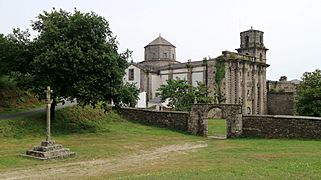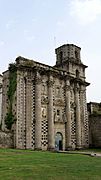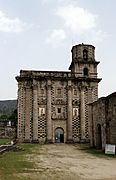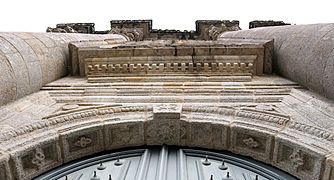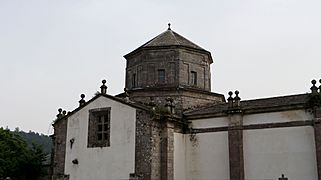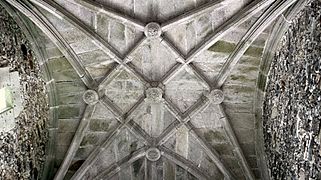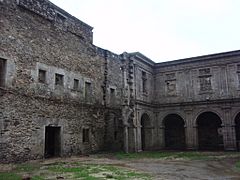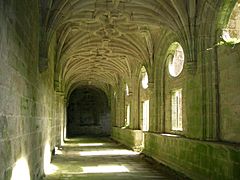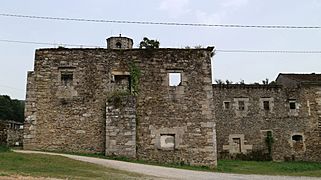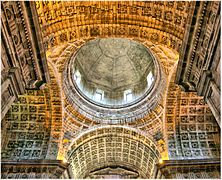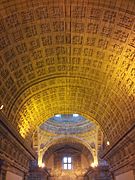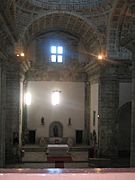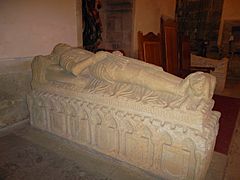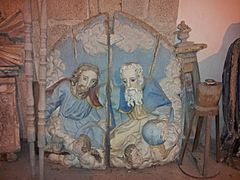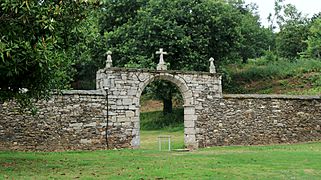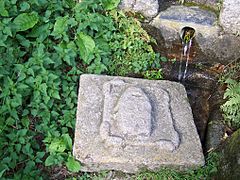Monfero Abbey facts for kids
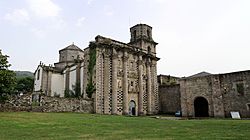
Abbey of Monfero
|
|
| Monastery information | |
|---|---|
| Order | Cistercian |
| Established | 1114 |
| People | |
| Founder(s) | Afonso VII the Emperor |
| Site | |
| Location | Monfero, Galicia (Spain) |
| Coordinates | 43°20′25″N 8°02′00″W / 43.3403°N 8.03333°W |
| Visible remains | substantial |
| Public access | yes |
Monfero Abbey is an old monastery in Galicia, Spain. It was once a home for Cistercian monks who dedicated it to Mary, the mother of Jesus. You can find it in a place called Monfero, about 22 kilometers northeast of Betanzos. Today, it's a beautiful historical site that shows how people lived and worshipped many centuries ago.
Contents
A Look Back: The History of Monfero Abbey
How it Started
Long, long ago, in the 10th century, there was a small, quiet place where a hermit (someone who lives alone for religious reasons) used to stay. Later, a Benedictine monastery was built there. This first monastery was dedicated to Saint Mark and was supported by King Bermudo II.
Challenges and Rebuilding
Sadly, the monastery was attacked and destroyed by Normans (Viking raiders). But it wasn't forgotten! In 1134, King Alfonso VII and some important nobles, like Alfonso Bermúdez and Count Pedro Osório, helped rebuild it. They also gave the monastery land and money to help it grow.
Joining the Cistercian Order
In 1147, Monfero Abbey joined the Cistercian order. This was a big change! It became a "daughter house" of Sobrado Abbey, which means it was connected to a larger Cistercian family that followed the rules of Clairvaux Abbey. The Cistercians were known for their simple lives and hard work.
Changes Over Time
In the 16th century, Monfero Abbey became part of a larger group of Cistercian monasteries in Spain. Later, in the 17th century, something unexpected happened: the old Romanesque-style monastery was hit by lightning and destroyed!
But the monks didn't give up. They rebuilt the abbey between 1620 and 1658 in a new, fancy style called Baroque. In 1805, the church was hit by lightning again, causing more damage.
The End of the Abbey
The abbey's time as a monastery came to an end in 1835. This happened because the Spanish government, led by Juan Álvarez Mendizábal, decided to close many monasteries. This event is known as the "dissolution of the monasteries." After this, the monks had to leave, and the abbey was no longer used as a religious home.
Exploring the Buildings
The buildings you see today at Monfero Abbey are mostly from the 17th century. They are made from strong materials like granite and slate. The abbey is in a truly beautiful natural area.
The Church
The church is still used today. It's built in the shape of a Latin cross (like a cross with one long arm). It has a main area called a nave and two smaller areas on the sides called side aisles.
The front of the church, called the west front, is very special. It's built in the Baroque style and has four huge half-pillars and two half-pilasters. These are like decorative columns that stick out from the wall. They have a cool checkered pattern made from inlaid tiles. Inside the church, the main altar was built in 1666 and is also in the Baroque style. You can also find four old Gothic tombs of the de Andrade family inside the church.
Other Abbey Buildings
To the south of the church were the buildings where the monks lived and worked. These are called the conventual buildings. There used to be three cloisters (enclosed courtyards) where the monks could walk and meditate. Today, only a small part of one of the original Romanesque cloisters remains.
Gallery
-
Tomb of lord Nuno Freire de Andrade, o Mao (died 1431), who ruled Pontedeume, Ferrol and Vilalba
See also
 In Spanish: Monasterio de Santa María de Monfero para niños
In Spanish: Monasterio de Santa María de Monfero para niños



